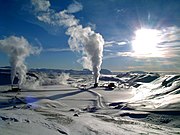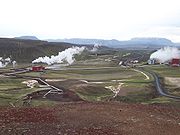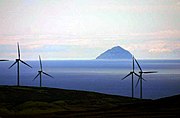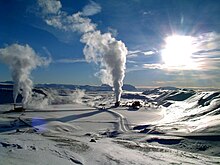Portal:Renewable energy/Selected article
| This page is currently inactive and is retained for historical reference. Either the page is no longer relevant or consensus on its purpose has become unclear. To revive discussion, seek broader input via a forum such as the village pump. |
| Note: Article entries here are now being transcluded directly on the main portal page. However, this page should be retained for historical reference. |
Note: When adding a new Selected article, please be sure to update the "max" value in the "Random portal component" function as well.

Hydroelectricity, or hydroelectric power, is electricity generated from hydropower (water power). Hydropower supplies 15% of the world's electricity, almost 4,210 TWh in 2023, which is more than all other renewable sources combined and also more than nuclear power. Hydropower can provide large amounts of low-carbon electricity on demand, making it a key element for creating secure and clean electricity supply systems. A hydroelectric power station that has a dam and reservoir is a flexible source, since the amount of electricity produced can be increased or decreased in seconds or minutes in response to varying electricity demand. Once a hydroelectric complex is constructed, it produces no direct waste, and almost always emits considerably less greenhouse gas than fossil fuel-powered energy plants. However, when constructed in lowland rainforest areas, where part of the forest is inundated, substantial amounts of greenhouse gases may be emitted.
Construction of a hydroelectric complex can have significant environmental impact, principally in loss of arable land and population displacement. They also disrupt the natural ecology of the river involved, affecting habitats and ecosystems, and siltation and erosion patterns. While dams can ameliorate the risks of flooding, dam failure can be catastrophic.
In 2021, global installed hydropower electrical capacity reached almost 1,400 GW, the highest among all renewable energy technologies. Hydroelectricity plays a leading role in countries like Brazil, Norway and China. but there are geographical limits and environmental issues. Tidal power can be used in coastal regions. (Full article...)

Hoover Dam is a concrete arch-gravity dam in the Black Canyon of the Colorado River, on the border between the U.S. states of Nevada and Arizona. Constructed between 1931 and 1936, during the Great Depression, it was dedicated on September 30, 1935, by President Franklin D. Roosevelt. Its construction was the result of a massive effort involving thousands of workers, and cost over 100 lives. In bills passed by Congress during its construction, it was referred to as the Hoover Dam, after President Herbert Hoover, but was named Boulder Dam by the Roosevelt administration. In 1947, the name Hoover Dam was restored by Congress.
Since about 1900, the Black Canyon and nearby Boulder Canyon had been investigated for their potential to support a dam that would control floods, provide irrigation water, and produce hydroelectric power. In 1928, Congress authorized the project. The winning bid to build the dam was submitted by a consortium named Six Companies, Inc., which began construction in early 1931. Such a large concrete structure had never been built before, and some of the techniques used were unproven. The torrid summer weather and lack of facilities near the site also presented difficulties. Nevertheless, Six Companies turned the dam over to the federal government on March 1, 1936, more than two years ahead of schedule. (Full article...)

Scout Moor Wind Farm is the second largest onshore wind farm in England. The wind farm, which was built for Peel Wind Power Ltd, produces electricity from 26 Nordex N80 wind turbines. It has a total nameplate capacity of 65 MW of electricity, providing 154,000 MW·h per year; enough to serve the average needs of 40,000 homes. The site occupies 1,347 acres (545 ha) of open moorland between Edenfield, Rawtenstall and Rochdale, and is split between the Metropolitan Borough of Rochdale in northern Greater Manchester and the Borough of Rossendale in south-eastern Lancashire. The turbines are visible from as far away as south Manchester, 15–20 miles (24–32 km) away.
A protest group was formed to resist the proposed construction, and attracted support from the botanist and environmental campaigner David Bellamy. Despite the opposition, planning permission was granted in 2005 and construction began in 2007. Although work on the project was hampered by harsh weather, difficult terrain, and previous mining activity, the wind farm was officially opened on 25 September 2008 after "years of controversy", at a cost of £50 million. (Full article...)

The history of ethanol fuel in Brazil dates from the 1970s and relates to Brazil's sugarcane-based ethanol fuel program, which allowed the country to become the world's second largest producer of ethanol, and the world's largest exporter. Several important political and technological developments led Brazil to become the world leader in the sustainable use of bioethanol, and a policy model for other developing countries in the tropical zone of Latin America, the Caribbean, and Africa. Government policies and technological advances also allowed the country to achieve a landmark in ethanol consumption, when ethanol retail sales surpassed 50% market share of the gasoline-powered vehicle fleet in early 2008. This level of ethanol fuel consumption had only been reached in Brazil once before, at the peak of the Pró-Álcool Program near the end of the 1980s. (Full article...)

Wind power became a significant energy source within South Australia over the first two decades of the 21st century. In 2015, there was an installed capacity of 1,475 MW, which accounted for 34% of electricity production in the state. This accounted for 35% of Australia's installed wind power capacity. In 2021, there was an installed capacity of 2052.95 MW, which accounted for 42.1% of the electricity production in the state in 2020.
The development of wind power capacity in South Australia has been encouraged by a number of factors. These include the Australian Government's Renewable Energy Target, which require electricity retailers to source a proportion of energy from renewable sources, incentives from the South Australian Government including a supportive regulatory regime and a payroll tax rebate scheme for large scale renewable energy developments. Also the state's proximity to the Roaring forties means there are high quality wind resources for wind farms to exploit. In mid-2009, RenewablesSA was established by the South Australian Government to encourage further investment in renewable energy in the state.
The load factor (or capacity factor) for South Australian wind farms is usually in the range of 32-38%. This means that a wind farm could typically produce between 32 and 38% of its nameplate capacity averaged over a year. (Full article...)

The use of solar energy began in Israel in the 1950s with the development by Levi Yissar of a solar water heater to address the energy shortages that plagued the new country. By 1967 around 5% of water of households were solar heated and 50,000 solar heaters had been sold. With the 1970s oil crisis, Harry Zvi Tabor developed the prototype of the solar water heater now used in over 90% of Israeli homes. There are over 1.3 million solar water heaters installed as a result of mandatory solar water heating regulations.
Israeli engineers have been at the cutting edge of solar energy technology and its solar companies work on projects around the world. However, even though Israeli engineers have been involved in both photovoltaic and concentrated solar power, the earliest Israeli companies which have become market leaders in their respective fields have all been involved in concentrated solar power. Some notable examples of this are BrightSource, Solel and Brenmiller Energy which all deal with utility scale projects. Additionally, Herzliya based SolarEdge has become a market leader in inverters for non-utility scale photovoltaic solar power. (Full article...)

Geothermal power is electrical power generated from geothermal energy. Technologies in use include dry steam power stations, flash steam power stations and binary cycle power stations. Geothermal electricity generation is currently used in 26 countries, while geothermal heating is in use in 70 countries.
As of 2019, worldwide geothermal power capacity amounts to 15.4 gigawatts (GW), of which 23.9% (3.68 GW) are installed in the United States. International markets grew at an average annual rate of 5 percent over the three years to 2015, and global geothermal power capacity is expected to reach 14.5–17.6 GW by 2020. Based on current geologic knowledge and technology the Geothermal Energy Association (GEA) publicly discloses, the GEA estimates that only 6.9% of total global potential has been tapped so far, while the IPCC reported geothermal power potential to be in the range of 35 GW to 2 TW. Countries generating more than 15 percent of their electricity from geothermal sources include El Salvador, Kenya, the Philippines, Iceland, New Zealand, and Costa Rica. Indonesia has an estimated potential of 29 GW of geothermal energy resources, the largest in the world; in 2017, its installed capacity was 1.8 GW. (Full article...)

Iceland is a world leader in renewable energy. 100% of the electricity in Iceland's electricity grid is produced from renewable resources. In terms of total energy supply, 85% of the total primary energy supply in Iceland is derived from domestically produced renewable energy sources. Geothermal energy provided about 65% of primary energy in 2016, the share of hydropower was 20%, and the share of fossil fuels (mainly oil products for the transport sector) was 15%.
The Icelandic government aspires that the nation will be carbon neutral by 2040. The largest obstacles to this are road transport and the fishing industry. (Full article...)

Solar energy is the radiant energy from the Sun's light and heat, which can be harnessed using a range of technologies such as solar electricity, solar thermal energy (including solar water heating) and solar architecture. It is an essential source of renewable energy, and its technologies are broadly characterized as either passive solar or active solar depending on how they capture and distribute solar energy or convert it into solar power. Active solar techniques include the use of photovoltaic systems, concentrated solar power, and solar water heating to harness the energy. Passive solar techniques include designing a building for better daylighting, selecting materials with favorable thermal mass or light-dispersing properties, and organize spaces that naturally circulate air.
In 2011, the International Energy Agency said that "the development of affordable, inexhaustible and clean solar energy technologies will have huge longer-term benefits. It will increase countries' energy security through reliance on an indigenous, inexhaustible, and mostly import-independent resource, enhance sustainability, reduce pollution, lower the costs of mitigating global warming .... these advantages are global". (Full article...)

Sustainable biofuel is biofuel produced in a sustainable manner. It is not based on petroleum or other fossil fuels. It includes not using plants that are used for food stuff to produce the fuel thus disrupting the world's food supply. (Full article...)

There are several solar power plants in the Mojave Desert which supply power to the electricity grid. Insolation (solar radiation) in the Mojave Desert is among the best available in the United States, and some significant population centers are located in the area. These plants can generally be built in a few years because solar plants are built almost entirely with modular, readily available materials. Solar Energy Generating Systems (SEGS) is the name given to nine solar power plants in the Mojave Desert which were built in the 1980s, the first commercial solar plant. These plants have a combined capacity of 354 megawatts (MW) which made them the largest solar power installation in the world, until Ivanpah Solar Power Facility was finished in 2014.
Nevada Solar One is a solar thermal plant with a 64 MW generating capacity, located near Boulder City, Nevada. The Copper Mountain Solar Facility is a 150 MW photovoltaic power plant in Boulder City, Nevada. The Ivanpah Solar Power Facility is a 370 MW facility which consists of three separate solar thermal power plants just off interstate highway 15 on the Nevada-California border in the Mojave Desert. There are also plans to build other large solar plants in the Mojave Desert. (Full article...)

Renewable energy commercialization involves the deployment of three generations of renewable energy technologies dating back more than 100 years. First-generation technologies, which are already mature and economically competitive, include biomass, hydroelectricity, geothermal power and heat. Second-generation technologies are market-ready and are being deployed at the present time; they include solar heating, photovoltaics, wind power, solar thermal power stations, and modern forms of bioenergy. Third-generation technologies require continued R&D efforts in order to make large contributions on a global scale and include advanced biomass gasification, hot-dry-rock geothermal power, and ocean energy. In 2019, nearly 75% of new installed electricity generation capacity used renewable energy and the International Energy Agency (IEA) has predicted that by 2025, renewable capacity will meet 35% of global power generation.
Public policy and political leadership helps to "level the playing field" and drive the wider acceptance of renewable energy technologies. Countries such as Germany, Denmark, and Spain have led the way in implementing innovative policies which has driven most of the growth over the past decade. As of 2014, Germany has a commitment to the "Energiewende" transition to a sustainable energy economy, and Denmark has a commitment to 100% renewable energy by 2050. There are now 144 countries with renewable energy policy targets. (Full article...)

Solar water heating (SWH) is heating water by sunlight, using a solar thermal collector. A variety of configurations are available at varying cost to provide solutions in different climates and latitudes. SWHs are widely used for residential and some industrial applications.
A Sun-facing collector heats a working fluid that passes into a storage system for later use. SWH are active (pumped) and passive (convection-driven). They use water only, or both water and a working fluid. They are heated directly or via light-concentrating mirrors. They operate independently or as hybrids with electric or gas heaters. In large-scale installations, mirrors may concentrate sunlight into a smaller collector.[original research?] (Full article...)

The production of renewable energy in Scotland is a topic that came to the fore in technical, economic, and political terms during the opening years of the 21st century. The natural resource base for renewable energy is high by European, and even global standards, with the most important potential sources being wind, wave, and tide. Renewables generate almost all of Scotland's electricity, mostly from the country's wind power.
In 2020, Scotland had 12 gigawatts (GW) of renewable electricity capacity, which produced about a quarter of total UK renewable generation. In decreasing order of capacity, Scotland's renewable generation comes from onshore wind, hydropower, offshore wind, solar PV and biomass. Scotland exports much of this electricity. On 26 January 2024, the Scottish Government confirmed that Scotland generated the equivalent of 113% of Scotland's electricity consumption from renewable energy sources, making it the highest percentage figure ever recorded for renewable energy production in Scotland. It was hailed as "a significant milestone in Scotland's journey to net zero" by the Cabinet Secretary for Wellbeing Economy, Fair Work and Energy, Neil Gray. It becomes the first time that Scotland produced more renewable energy than it actually consumed, and demonstrates the "enormous potential of Scotland's green economy" as claimed by Gray. (Full article...)

The Geysers is the world's largest geothermal field, containing a complex of 18 geothermal power plants, drawing steam from more than 350 wells, located in the Mayacamas Mountains approximately 72 miles (116 km) north of San Francisco, California.
Geysers produced about 20% of California's renewable energy in 2019. (Full article...)
Article 16 Mandatory renewable energy targets are part of government legislated schemes which require electricity merchandisers to source-specific amounts of aggregate electricity sales from renewable energy sources according to a fixed time frame. The objective of these schemes is to promote renewable energy and decrease dependency on fossil fuels. If this results in an additional expenditure of electricity, the additional cost is distributed across most customers by increases in other tariffs. The cost of this measure is therefore not funded by the government budgets, except for costs of establishing and monitoring the scheme and any audit and enforcement actions. As the cost of renewable energy has become cheaper than other sources, meeting and exceeding a renewable energy target will also reduce the expenditure of electricity to consumers.
At least 67 countries have renewable energy policy targets of some kind. In Europe, 28 European Union members states and 8 Energy Community Contracting Parties have legally binding renewable energy targets. The EU baseline target is 20% by 2020, while the United States also has a national RET of 20%. Similarly, Canada has 9 provincial RETs but no national target for renewable energy (although it does have a 2030 non-emitting target and coal phase-out by 2030). Targets are typically for shares of electricity production, but some are defined as by primary energy supply, installed capacity, or otherwise. While some targets are based on 2010-2012 data, many are now for 2020, which bonds in with the IPCC suggested greenhouse gas emission cuts of 25 to 40% by Annex I countries by 2020, although some are for 2025. (Full article...)

The Three Gorges Dam (simplified Chinese: 三峡大坝; traditional Chinese: 三峽大壩; pinyin: Sānxiá Dàbà) is a hydroelectric gravity dam that spans the Yangtze River near Sandouping in Yiling District, Yichang, Hubei province, central China, downstream of the Three Gorges. The world's largest power station in terms of installed capacity (22,500 MW), the Three Gorges Dam generates 95±20 TWh of electricity per year on average, depending on the amount of precipitation in the river basin. After the extensive monsoon rainfalls of 2020, the dam's annual production reached nearly 112 TWh, breaking the previous world record of ~103 TWh set by Itaipu Dam in 2016.
The dam's body was completed in 2006; the power plant was completed and fully operational by 2012, when the last of the main water turbines in the underground plant began production. Each of the main water turbines has a capacity of 700 MW. Combining the capacity of the dam's 32 main turbines with the two smaller generators (50 MW each) that provide power to the plant itself, the total electric generating capacity of the Three Gorges Dam is 22,500 MW. The last major component of the project, the ship lift, was completed in 2015. (Full article...)

A tide mill is a water mill driven by tidal rise and fall. A dam with a sluice is created across a suitable tidal inlet, or a section of river estuary is made into a reservoir. As the tide comes in, it enters the mill pond through a one-way gate, and this gate closes automatically when the tide begins to fall. When the tide is low enough, the stored water can be released to turn a water wheel.
Tide mills are usually situated in river estuaries, away from the effects of waves but close enough to the sea to have a reasonable tidal range. Cultures that built such mills have existed since the Middle Ages, and some may date back to the Roman period. (Full article...)

Renewable energy in Russia mainly consists of hydroelectric energy. The country is the fifth largest producer of renewable energy in the world, although it is 56th when hydroelectric energy is not taken into account. Only 179 TWh of Russia's energy production comes from renewable energy sources, out of a total economically feasible potential of 1823 TWh. Only 16% of Russia's electricity is generated from hydropower, and less than 1% is generated from all other renewable energy sources combined. Roughly 68% of Russia's electricity is generated from thermal power and 16% from nuclear power. The abundance of fossil fuels in the Soviet Union and the Russian Federation has resulted in little development of the renewable energy sector. There are currently plans to expand the share of renewable energy in Russia's energy output, plans strongly encouraged by the Russian government. Russian President Dmitry Medvedev has called for renewable energy to have a larger share of Russia's energy output, and has taken steps to promote the development of renewable energy in Russia since 2008.
Read More...

Grand Coulee Dam is a gravity dam on the Columbia River in the U.S. state of Washington built to produce hydroelectric power and provide irrigation. It was constructed between 1933 and 1942, originally with two power plants. A third power station was completed in 1974 to increase its energy production. It is the largest electric power-producing facility in the United States and one of the largest concrete structures in the world.
Power from the dam fueled the growing industries of the Northwest United States during World War II. Between 1967 and 1974, the Third Powerplant was constructed. The decision to construct the additional facility was influenced by growing energy demand, regulated river flows stipulated in the Columbia River Treaty with Canada and competition with the Soviet Union. Through a series of upgrades and the installation of pump-generators, the dam now supplies four power stations with an installed capacity of 6,809 MW. As the center-piece of the Columbia Basin Project, the dam's reservoir supplies water for the irrigation of 671,000 acres (2,700 km2).
Read More...

The incentive to use 100% renewable energy has been created by global warming and other ecological as well as economic concerns. Renewable energy use has grown much faster than anyone anticipated. The Intergovernmental Panel on Climate Change has said that there are few fundamental technological limits to integrating a portfolio of renewable energy technologies to meet most of total global energy demand. Mark Z. Jacobson says producing all new energy with wind power, solar power, and hydropower by 2030 is feasible and existing energy supply arrangements could be replaced by 2050. Barriers to implementing the renewable energy plan are seen to be "primarily social and political, not technological or economic". Jacobson says that energy costs with a wind, solar, water system should be similar to today's energy costs. Critics of the "100% renewable energy" approach include Vaclav Smil and James E. Hansen.
Read More...
Article 22 Portal:Renewable energy/Selected article/22
Article 23 Portal:Renewable energy/Selected article/23
Article 24 Portal:Renewable energy/Selected article/24
Article 25 Portal:Renewable energy/Selected article/25

